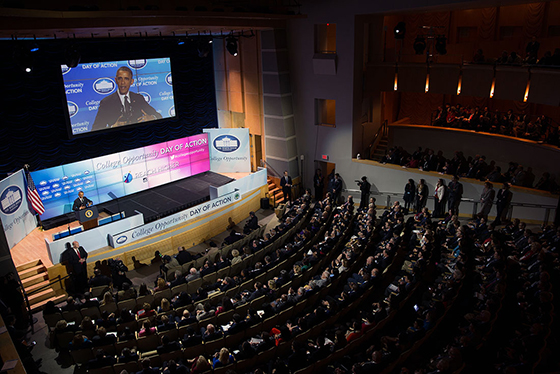
Maintaining the momentum from the January College Opportunity Summit, OSTP organized regional convenings on improving STEM undergraduate learning on college campuses this past fall, to learn the progress being made by institutions and organizations who made January commitments and to broaden the coalition for yesterday’s Day of Action.
Among the 110 new initiatives and actions to improve STEM college completion being announced yesterday, are efforts to: increase STEM graduation rates at college and universities up to 35% over the next 5 to 10 years—producing thousands of more students that help us reach the Administration’s goal of 1 million additional STEM graduates by 2022, expand mentoring, financial aid, tutoring, and internships for women and minorities pursuing STEM fields, move away from traditional lecture-based courses to more active classrooms that encourage students to solve problems in small groups and hands-on experiments and modeling- methods that both increase student learning and student retention in STEM majors, and make progress on the Administration’s goal to prepare more excellent K-12 teachers with expertise in STEM areas.
For example:
- California State University Los Angeles, which serves as a gateway to higher education for youth in East Los Angeles where over 95 percent of residents are Hispanic and more than 25 percent live below the poverty line, seeks to increase the number of STEM degrees awarded to underrepresented minorities by 25 percent in the next five years through a summer bridge program and focusing on the first year experience of students in the College of Engineering, Computer Science, and Technology.
- Dallas County Community College District committed to implementing a number of interconnected strategies to identify, recruit, and support more low-income, female, and underrepresented STEM students culminating in an additional 1200 students annually by 2020 with a graduation rate better than 50 percent.
- Florida International University (FIU), a minority serving institution with over 11,000 STEM majors approximately 8,800 of whom are from groups underrepresented in STEM, commits to increasing overall STEM graduate rates by 10%, through providing faculty with the time and funding to receive professional development in evidence-based teaching methods and integrating the culture of evidence-based instruction into faculty assignments, evaluation, tenure, and promotion processes.
- Through its collaborative engineering program initiative with the University of Texas (UT) at Tyler, Houston Community College (HCC) committed to increase the number of engineering college graduates by 200 students annually, particularly those from underrepresented groups). The increase would reflect a 20% and 15% completion rate, respectively, for HCC and UT Tyler.
- Nebraska Wesleyan University commits to improving second-year retention in STEM fields by 15 percent over the three years by overhauling introductory biology courses to connect students to scientific research earlier in their STEM college career.
- Southern Illinois University Edwardsville (SIUE) commits to increase STEM degree completion by 15 percent, and to double the number of underrepresented minority students enrolled in a STEM degree program, through offering opportunities for STEM experiential learning, as well as supporting academic departments to implement evidence-based teaching practices in introductory courses, including course-based research experiences.
- Over the coming year, the Helmsley Charitable Trust expects to commit an additional $10 million in funds to support nationally scalable efforts, particularly among community colleges and institutions that serve less resourced communities of students to support STEM student success.
- Eight individual initiatives or institutions – including the State University of New York (SUNY), Uteach in partnership with the National Math and Science Initiative, CalTeach in the California State University System, Southern Connecticut State University, Westminster College, Stetson University, and Temple University – will prepare more than 10,000 excellent K-12 teachers with expertise in STEM fields to inspire the next generation of STEM innovators. This represents continued progress on the President’s goal to produce an additional 100,000 excellent K-12 STEM teachers over a decade.
The day featured new Administration commitments, including the release of a Dear Colleagues letter from the National Science Foundation (NSF) calling for proposals to pilot innovations for helping students learn the mathematics taught in the first two years of college and to plan and execute workshops in 2015 on using research to improve student success in mathematics in the first two years of college. Programs supporting this work in the Directorate for Education and Human Resources include Improving Undergraduate STEM Education, Advanced Technological Education, Historically Black Colleges and Universities Undergraduate Program, Tribal Colleges and Universities Program, Innovative Technology Experiences for Students and Teachers, and Discovery Research K-12.
Improving STEM degree completion was one of four key action areas for the Day of Action which also included, building networks of colleges focused on promoting completion, creating K-16 partnerships around college readiness, and investing in high school counselors as part of the First Lady’s Reach Higher initiative.
Learn More:


